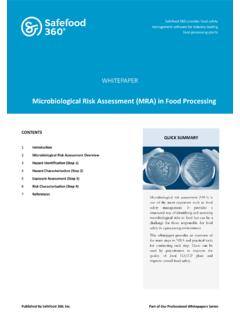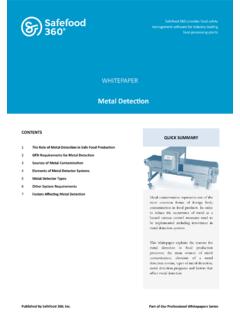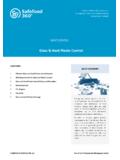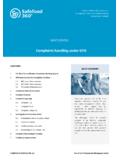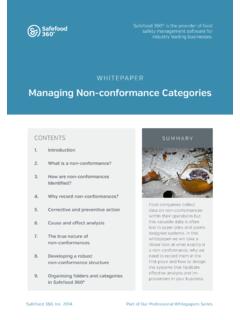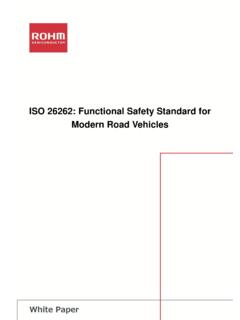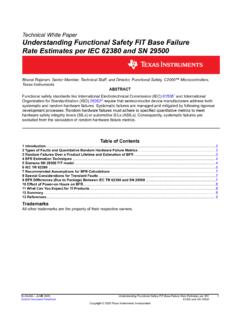Transcription of Risk Assessment of Suppliers & Materials
1 Safefood 360 User Conference New Orleans, 2016 Risk Assessment of Suppliers & MaterialsChris Domenico, Territory ManagerSafefood 360 User Conference New Orleans, 2016 Risk Assessment of Suppliers & Materials Agenda Overview Why do we need risk assessments? What is the risk? Quality Risk Management / Basic Risk Assessment Material Risk Assessment GFSI Rules New HARPC RulesSafefood 360 User Conference New Orleans, 2016 Supply ChainSafefood 360 User Conference New Orleans, 2016 Supply Chain A Supply Chain has many vendors that need to be assessed for the risk they pose to the organization A vendor risk analysis process should be in place ot determine where weaknesses are from a technical point of view in the supply chainSafefood 360 User Conference New Orleans.
2 2016 Risk Assessment in the Supply ChainExternal PartnersRaw MaterialsStorage & HandlingProcessingShipping/ TransportSafefood 360 User Conference New Orleans, 2016 Why Risk Assessments? Managing vendor risk is an ongoing process You want to get the biggest bang for your buck from your program You want to ensure that the information you learn is used to make better decisionsSafefood 360 User Conference New Orleans, 2016 Why Risk Assessments? Organizations implement vendor risk management programs as a formal way to evaluate, track and measure third-party risk To assess its impact on all aspects of the business To develop compensating controls of mitigation to lessen the impact on your business should something happenSafefood 360 User Conference New Orleans, 2016 Supply Chain ChallengesSafefood 360 User Conference New Orleans, 2016 Supply Chain Challenges Suppliers pose a challenge to any organization People.
3 Contractors in and out of the company Reliance of Supplier background checks Process: Each department can manage the Supplier relationship differently Essentially, you are assuming the liability of a 3rd party!Safefood 360 User Conference New Orleans, 2016 What is the risk? Management Systems are frequently inaccurate if no Processes are prone to error (Emails, Word documents, Phone Calls, Snail Mail) cataloging of companies have particular challenges with many business units, time zones, varying regulatory of consistent testing methodsSafefood 360 User Conference New Orleans, 2016 Quality Risk Management ProcessDefinequality risks and owners of risksMeasureand rank risks (Complete gap analysis)
4 Analyzecurrent risk mitigation processes in place for key risksImproverisk mitigation guidance and processesControl Monitor compliance of risk mitigation plansSafefood 360 User Conference New Orleans, 2016 Basic Risk Risk of Ingredient, Materials , or of ingredients or Materials supplier history and performanceLow = 1 Medium = 2 High = 3 LowMediumHigh34 -67 -9 Safefood 360 User Conference New Orleans, 2016 Basic Risk AssessmentBased on the RA a decision can be made on the: Method of supplier approval Questionnaire, Supplier Audit, 3rd Party Certification Method of supplier monitoring and degree of monitoring Type and frequency of raw material sampling and testing requiredSafefood 360 User Conference New Orleans, 2016 Material Risk Assessment Many hazards can be introduced into a facility through raw Materials Some hazards to assess.
5 Pathogens, Allergens, Chemical Residues, Pests, Foreign MaterialSafefood 360 User Conference New Orleans, 2016 Material Risk Assessment Be clear on the hazards Identify what can go wrong (hazard) Assess that hazard (likelihood / severity) Basic hazards to address: Allergens, microbiological, chemical, and phsyical Regulatory, intrinsic hazards (pitts in fruit, bones in chicken), geographical origin, purchase formatSafefood 360 User Conference New Orleans, 2016 Geo-mapping in Safefood 360 Safefood 360 User Conference New Orleans, 2016 Safefood 360 User Conference New Orleans, 2016 Material Risk Assessment Define risk Assessment ratings Have clear definitions associated with your likelihood and consequence ratings If something is rated medium what does that actually mean in relation to the hazard you have identified?
6 What is the impact on both the consumer and the business?Safefood 360 User Conference New Orleans, 2016 Material Risk Assessment Research your hazards The more thorough your raw material risk Assessment the better Identify threats to your business and food consumers Resources: recall databases, FDA raw material profiles, your own experience, government food importation departmentSafefood 360 User Conference New Orleans, 2016 Risk Assessment RequirementsSafefood 360 User Conference New Orleans, 2016 GFSI GFSI to require specific food fraud mitigation strategies in 2016 GFSI Board believes mitigation of Food Fraud is an integral part of a company s FSMS GFSI to support SSAFE (Safe Supply of Affordable Food Everywhere)
7 Developing guidelines for companies on how to assess and control food fraud vulnerabiliities within their organization and supply chainSafefood 360 User Conference New Orleans, 2016 GFSI : British Retail Consortium (BRC) BRC: Fundamental Requirement Increased requirements for supplier Risk Assessments Sites required to verify an effective traceability system for all Suppliers Verify traceability to the last manufacturer, packer, or grower when raw Materials are packaged and purchased from an agent or brokerSafefood 360 User Conference New Orleans, 2016 GFSI : British Retail Consortium (BRC) BRC.
8 Section 3 Authenticity of Food (Food Fraud) motivated substituion Risk Assessment that includes Food Fraud and Material Substitutions is now required ANNUALLY (Must be reviewed by Management during the management review process!)Safefood 360 User Conference New Orleans, 2016 FSMA FSMA implementation will be the largest change in the food industry in its implementation as well its enforcement Implementation processes and compliance tools will be the largest investment many companies will make over the next 5 yearsSafefood 360 User Conference New Orleans.
9 2016 FSMA The rules require a supplier approval and verification program This applies to each buyer along the supply chain up to but not including retail/foodservice and sales establishmentsSafefood 360 User Conference New Orleans, 2016 FSMA : Food safety Plan Requirements Written supplier approval and verification program A risk based approach to ensure Suppliers are not providing food facilities with raw Materials or ingredients that pose a significant risk to the final product made by the facilitySafefood 360 User Conference New Orleans, 2016 FSMA Processors must conduct a hazard analysis of all their raw Materials , ingredients.
10 And packaging Materials Incorporate the material in question as well as the manufacturer and country of origin For food processors that have made the committment to pursue and implement a GFSI audit scheme, this Assessment will be an essential element of their programSafefood 360 User Conference New Orleans, 2016 FSMA : HARPC The scope of your risk and hazard analysis includes a full supply chain evaluation Broader spectrum of hazards and their source (natural/manmade, inentional/unintentional) Biological, Physical, Chemical, and Radiological Natural Toxins, Pesticides, Drug Residues, Decomposition, Parasites, Allergens, Unapproved Food and Color AdditivesSafefood 360 User Conference New Orleans, 2016 FSMA : HARPC.
